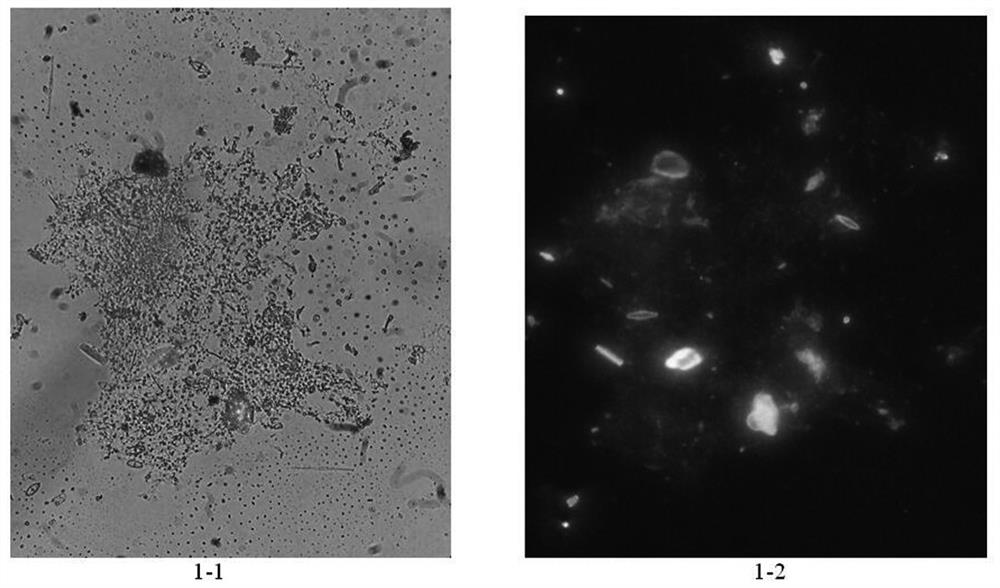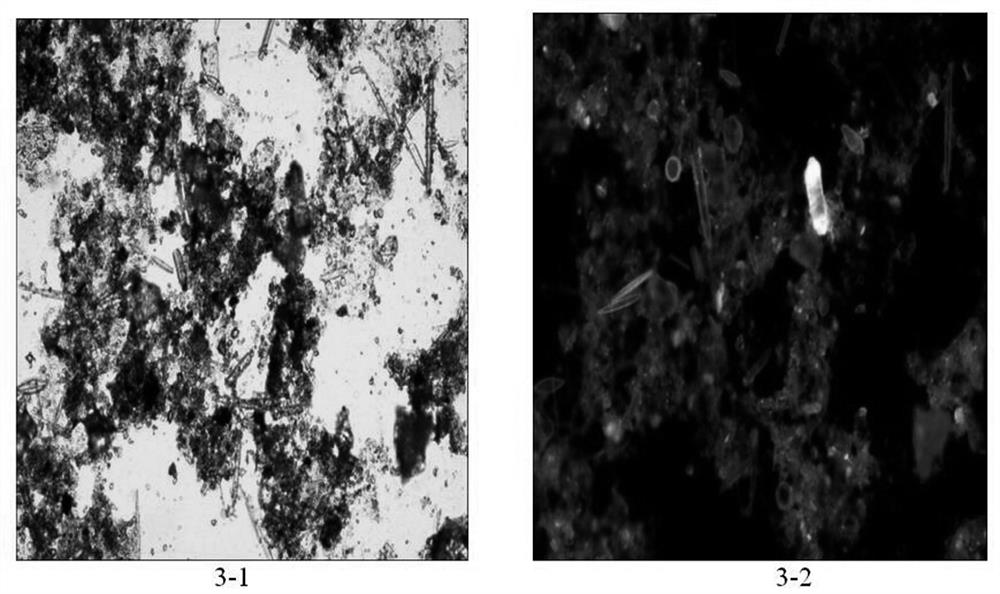A kind of diatom fluorescent staining solution and diatom detection method for detecting visceral tissue
A fluorescent dyeing and inspection method technology, applied in the field of diatom inspection, can solve the problems that diatoms are not easy to be dyed, affect the judgment of corpses, and the diatom morphology is not completely displayed, so as to shorten the detection time, improve work efficiency, and avoid missed detection Effect
- Summary
- Abstract
- Description
- Claims
- Application Information
AI Technical Summary
Problems solved by technology
Method used
Image
Examples
Embodiment 1
[0032] The diatom fluorescent dyeing solution is composed of the following components in weight percent: 10% fluorescein, 5% mordant, 0.3% hydrofluoric acid, and the rest is deionized water.
[0033] A method for diatom testing using a diatom fluorescent staining solution to detect visceral tissues, comprising the following steps:
[0034] 1) Apply the digestive juice obtained after nitrification of visceral tissues (kidney tissues from drowned corpses) on a glass slide, dry to obtain a smear of the tissue to be tested, and add diatom fluorescence to the smear of the tissue to be tested Put the staining solution in a wet box and place it in a water bath, keep it warm for 20 minutes at 37°C, rinse it with distilled water, put it in a drying machine, and dry it for 4 minutes at 60°C;
[0035] 2) Add decolorization solution to the dried tissue smear in step 1), let it stand for 4 seconds, rinse it with distilled water, put it in a drying machine, dry it at 60°C, and seal the slid...
Embodiment 2
[0041] The diatom fluorescent staining solution is composed of the following components in weight percentage: 10% fluorescein, 5% mordant (aluminum salt), 0.3% hydrofluoric acid, and the rest is deionized water.
[0042] A method for diatom testing using a diatom fluorescent staining solution to detect visceral tissues, comprising the following steps:
[0043] 1) Smear the digestive juice obtained after nitrification of organ tissue (taken from lung tissue) on a glass slide, dry it to obtain a smear of the tissue to be tested, add diatom fluorescent staining solution dropwise to the smear of the tissue to be tested, Put it in a wet box and place it in a water bath, keep it warm for 20 minutes at 37°C, rinse it with distilled water, put it in a drying machine, and dry it for 4 minutes at 60°C;
[0044]2) Add decolorization solution dropwise to the dried tissue smear in step 1), let it stand for 4 seconds, rinse it with distilled water, and dry it at 60°C for 4 minutes. The amo...
Embodiment 3
[0051] A diatom fluorescent staining solution is composed of the following components by weight percentage: 8% fluorescein, 3% mordant (aluminum salt), 0.5% hydrofluoric acid, and the rest is deionized water.
[0052] A method for diatom testing using a diatom fluorescent staining solution to detect visceral tissues, comprising the following steps:
[0053] 1) Apply the digestive juice obtained after nitrification of visceral tissues (kidney tissues from drowned corpses) on a glass slide, dry to obtain a smear of the tissue to be tested, and add diatom fluorescence to the smear of the tissue to be tested Put the staining solution in a wet box and place it in a water bath, keep it warm for 20 minutes at 37°C, rinse it with distilled water, put it in a drying machine, and dry it for 4 minutes at 60°C;
[0054] 2) Add decolorization solution to the dried tissue smear in step 1), let it stand for 4 seconds, rinse it with distilled water, put it in a drying machine, dry it at 60°C,...
PUM
 Login to View More
Login to View More Abstract
Description
Claims
Application Information
 Login to View More
Login to View More - Generate Ideas
- Intellectual Property
- Life Sciences
- Materials
- Tech Scout
- Unparalleled Data Quality
- Higher Quality Content
- 60% Fewer Hallucinations
Browse by: Latest US Patents, China's latest patents, Technical Efficacy Thesaurus, Application Domain, Technology Topic, Popular Technical Reports.
© 2025 PatSnap. All rights reserved.Legal|Privacy policy|Modern Slavery Act Transparency Statement|Sitemap|About US| Contact US: help@patsnap.com



